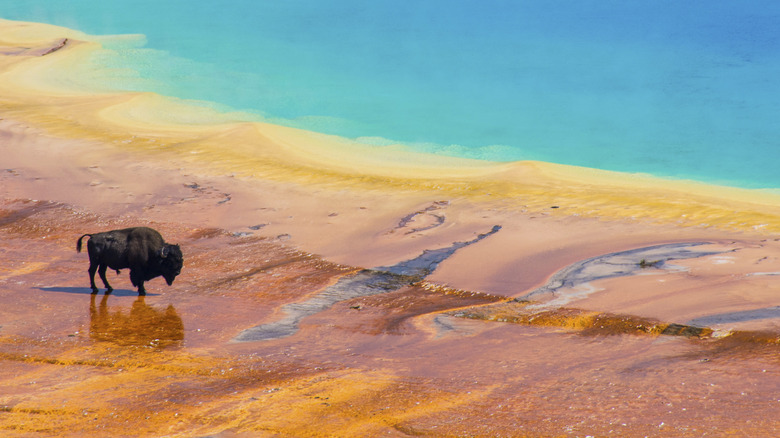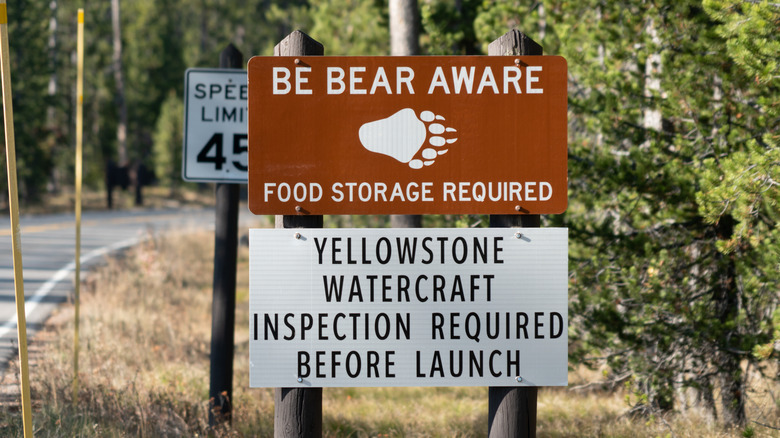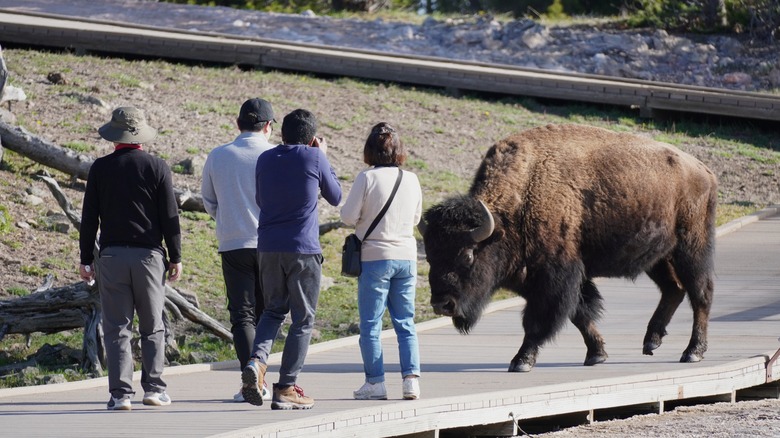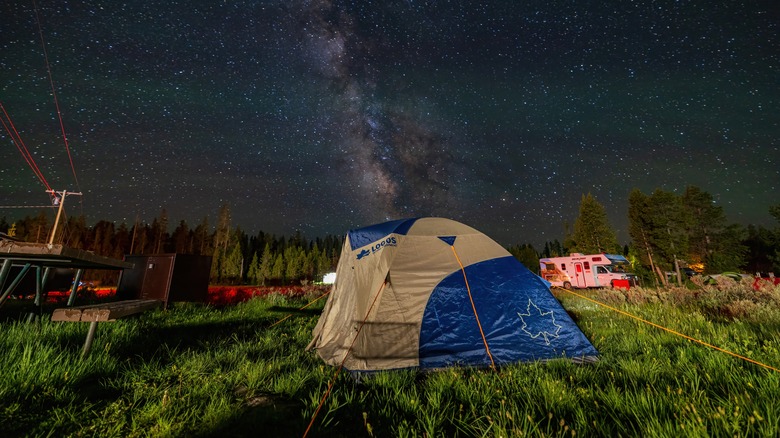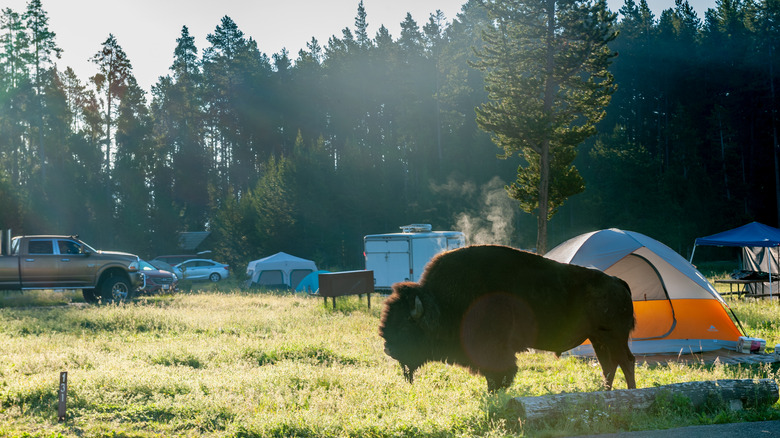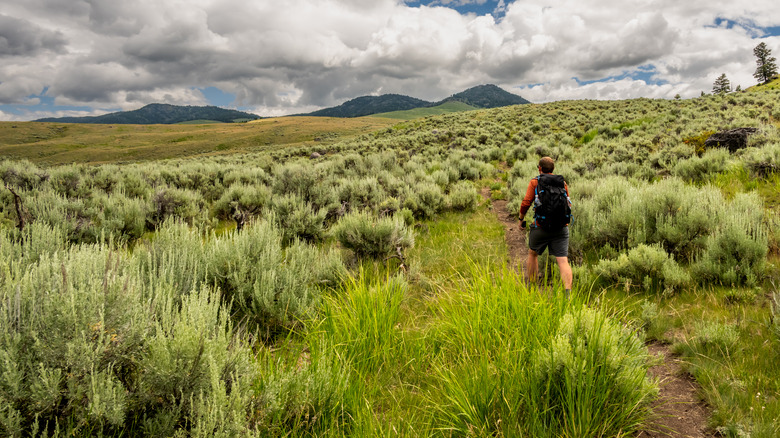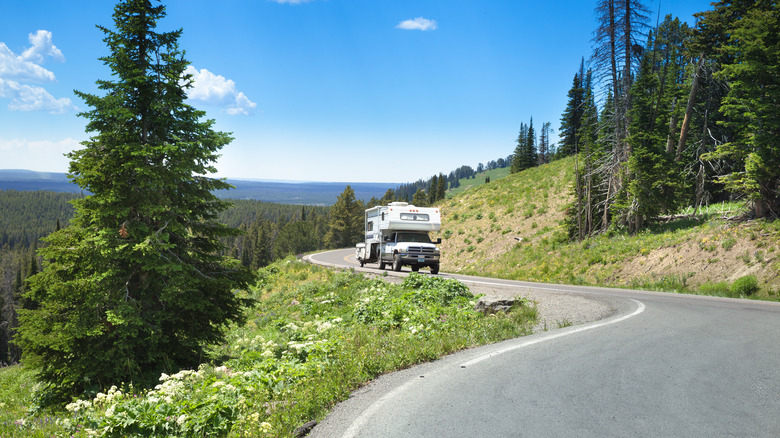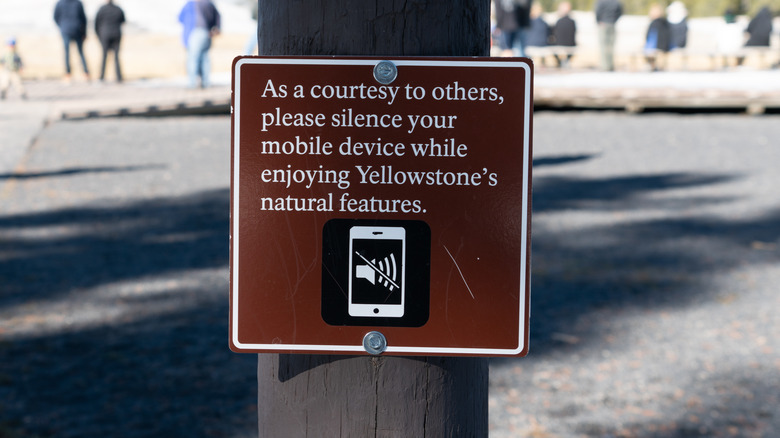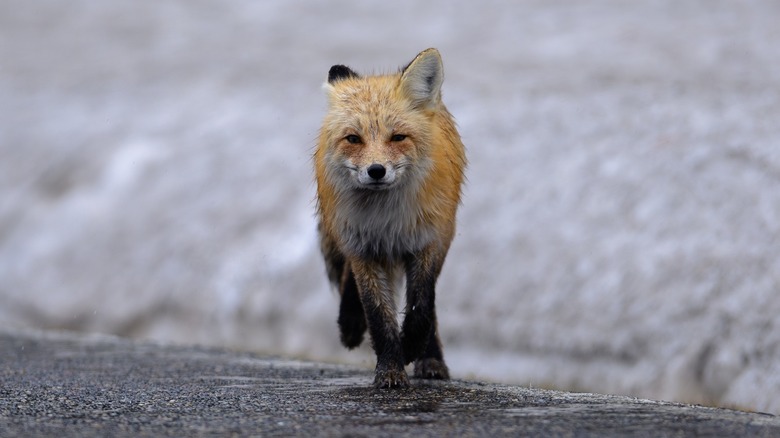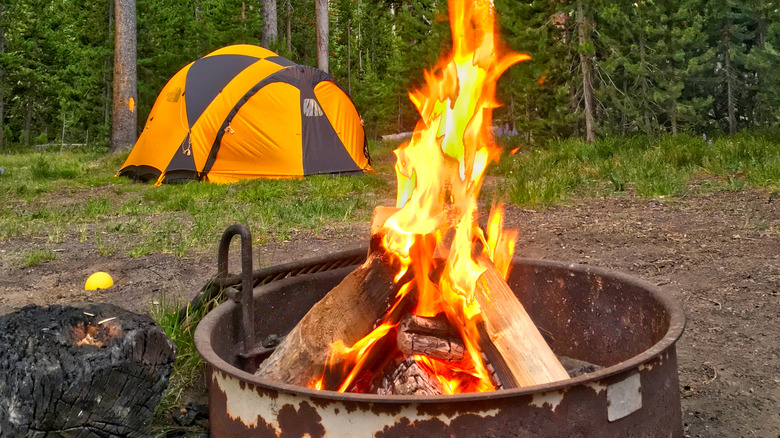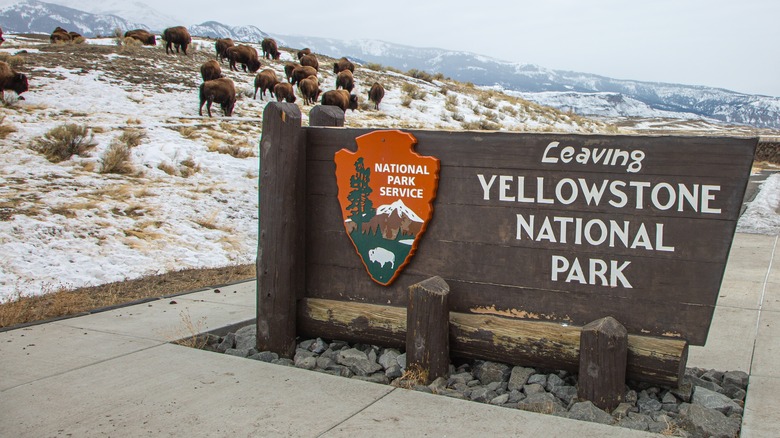What You Should Know Before Camping In Yellowstone National Park
We may receive a commission on purchases made from links.
Yellowstone National Park sprawls across 2.2 million acres of land spanning three U.S. states: Wyoming, Montana, and Idaho. It sits atop the Yellowstone Caldera, a supervolcano born from a cataclysmic eruption some 640,000 years ago. Volcanic plateaus rise between the jagged peaks of the Absaroka and Gallatin ranges, while forests of lodgepole pine blanket their slopes. It's a vast wilderness of canyons, rivers, and bison thundering across meadows, while geysers shoot to the skies, and steam vents rise through cracks in the earth.
Native American tribes lived and hunted these lands long before the wagon trains creaked westward. They tracked elk and other game through the valleys and forests and gathered at thermal springs for ceremonies. In 1872, driven by a desire to preserve its geothermal wonders, President Ulysses S. Grant declared Yellowstone a national park — a bold idea that no country had ever attempted. Just over a hundred years later, Yellowstone was designated a UNESCO World Heritage Site.
Nowadays, ribbons of asphalt and regulated campgrounds funnel millions of visitors through controlled corridors every year. Other than that, the wilderness remains untouched, and there are lists of rules as long as your arm to ensure things stay that way. However, these rules don't only protect the wilderness; they also safeguard visitors. This park is full of wild animals, dangerous ones tourists should never approach, and pets must always be kept on a leash — for their own protection as much as anything else. In fact, taking your pet everywhere is one of the most common mistakes people make in the park. Drones are banned to maintain clear skies for birds of prey and ensure the profound silence of the park is uninterrupted, and there are many other essentials that you must know before visiting Yellowstone. Here are a few of the more important ones.
You should store food properly to avoid attracting wildlife
Grizzly bears are hungry animals, and there are around 1,000 of them wandering the Greater Yellowstone region. As a visitor, it's illegal to feed wildlife, and you are responsible for not attracting them with scents, including your food. They can sniff out food easily and often mistake cosmetics, bug spray, and dirty cookware for meals. And if a bear knows there is a meal in a particular place, it will return. We're not talking about Pooh Bear with a pot of honey here, either. They might be wary of humans, but grizzlies are dangerous animals.
Feasting on trash and scraps left out at night means a bear could soon favor our food over its natural diet. Eventually, it will also lose its fear of people. And when this happens, it will start to actively seek us out when it gets the munchies — and its behavior could get aggressive and erratic. A bear that becomes relentless in its quest for easy meals needs to be dealt with, and park authorities will either relocate it, which will probably end up with the same behavior, or "remove" it, which means it will be euthanized.
But it's not only grizzlies you need to beware of. Black bears are also an issue, while coyotes, foxes, and even squirrels may turn up uninvited for dinner. Yellowstone requires all food and scented items to be stored correctly — either locked up in your vehicle or sealed in an approved bear-resistant container. You can also legally hang your food 10 feet off the ground and four feet from the nearest tree as a backup method when hiking the backcountry.
You should keep your distance from wildlife
It can be tempting to take selfies close to wild animals. But they are just that. Wild animals. And they are dangerous. The National Park Service (NPS) requires that you keep a minimum distance of 100 yards (300 feet/91.5 meters) from bears, wolves, and mountain lions and at least 25 yards (75 feet/23 meters) from other large animals such as elk, bison, moose, and coyotes. In fact, it's the bison you might want to be most wary of, as they are responsible for more injuries to visitors than all other animals in Yellowstone. But if any wild animal in the park starts acting differently in your presence or starts to approach you, it could mean you have violated its space.
Animals won't measure your distance before showing their discomfort. Those NPS guidelines are minimums, and you might want to keep even farther back to be safe. You should use a telephoto lens if you have a proper camera, and for simple wildlife viewing, invest in a good set of binoculars. Park regulations also prohibit visitors from howling and mimicking other animal noises, such as the elk's bugle. And let's be honest, if you do it, you've no idea what signal you might be giving. You could be indicating that you're a threat or are invading its territory, and while wolf attacks are extremely rare, you don't want to be the one to test its temperament. All wild animals are potentially dangerous; females with offspring are particularly volatile, while bull elk display heightened aggression during the mating season in the fall. In Yellowstone, or any national park for that matter, pay attention to the mandatory NPS distance requirements.
Campsites require reservations in advance
Yellowstone offers the full range of camping setups, from rustic tent sites to full-service RV facilities. The park has 11 campgrounds with more than 2,000 designated campsites. However, reservations are generally required, and the system works on a rolling basis. Each camping date becomes reservable six months in advance for NPS campgrounds and 13 months in advance (on the fifth of each month) for those run by Yellowstone National Park Lodges. If you do want to stay in the park during the peak season, which runs from July 1 through Labor Day on the first Monday in September, you can only stay 14 nights in most campgrounds, with a hard 44-night limit for the entire summer. Additionally, you cannot choose which site you want when booking; site assignments happen upon your arrival, and each site is limited to six people.
Fishing Bridge RV Park is the only campground without a stay limit. It also stands alone as the only full-hookup option in Yellowstone — that means electricity, running water, and waste disposal. On the other hand, the dry Mammoth Campground operates on a first-come, first-served basis during the October 15 to April 1 off-season. In fact, Mammoth is the only campground in operation during the winter months. If you're not one for rustic camping in frigid conditions, Mammoth Hot Springs Hotel & Cabins and Old Faithful Snow Lodge keep their doors open throughout winter. If you do visit at this time, you are allowed to stay a maximum of 30 nights as a reward for braving the cold.
Camping is in designated campgrounds and backcountry campsites
As appealing as pulling over beside a sweeping valley to catch the perfect sunrise or pitching your tent by a lake may sound, overnight stays in Yellowstone are only permitted in designated campgrounds. Even when hiking in the backcountry, you're limited to designated campsites. Sleeping in your vehicle in pullouts, picnic areas, or parking lots, or randomly pitching your tent wherever, is prohibited — and rangers patrol these areas and will ticket or remove violators. Unless you are hiking, you must spend the night in one of the park's 11 campgrounds. Most can accommodate RVs or tents, but the experience varies considerably. Larger sites such as Canyon, Grant Village, and Madison offer conveniences including toilets, hot showers, and dump stations. Smaller campgrounds like Slough Creek, Tower Fall, and Pebble Creek offer peaceful, back-to-basics stays with fewer amenities.
However, you can sleep in your car within the boundaries of a paid campsite — but even in the summer months, it can get nippy during the night, making a quality sleeping bag an essential purchase. If you're camping in your tent, avoid Fishing Bridge RV Park; bear activity in the area means there is a strict ban on pitching. It does, however, offer full hookups for anyone visiting in a hard-sided RV. Backcountry backpackers also can't just pitch anywhere. There are 293 designated campsites dotted throughout the park for you to discover. Just remember to obtain a permit before clicking your heels and skipping off into the wilderness.
Backcountry camping requires a permit
The backcountry in Yellowstone National Park offers some humbling wilderness adventures. There are multi-day journeys through isolated valleys, high-altitude plateaus, and steaming geothermal basins that you'll likely have all to yourself. Black Canyon, Shoshone Lake, and Snake River are among the most rewarding backpacking trips. But wherever you decide to set off on your big adventure, a backcountry permit is required. You can only pitch your tent in designated backcountry campsites, too, but there are almost 300 of them scattered around.
As you might expect, backcountry facilities strip away the luxuries and leave you with nothing much beyond a level pitching spot, a fire ring, and either a bear box for storage or a food-hanging pole. You'll also find water sources, but remember to pack a reliable, lightweight filter or treat the water before drinking. You can only stay for a maximum of three consecutive nights, unless otherwise specified, and fees include a $5 per night charge, plus a non-refundable application or reservation charge. Permits can be reserved in advance at recreation.gov and must be collected in person at the Backcountry Permit Office before departure. Campsites start opening up in early spring, although some operate on a walk-in basis and must be claimed in person within 48 hours before your departure.
RVs have specific restrictions and services
It's essential you consider the size of your RV before traveling to Yellowstone. You'll face challenges with an oversized rig when squeezing into pull-outs or finding somewhere to park. Certain Yellowstone roads are also subject to narrow passages, while low-clearance bridges can be an issue. If you're in charge of a substantial rig, stay clear of the scenic gateway route, Beartooth Highway, and the road from Tower Falls to Canyon.
Campgrounds require that you state the combined length of your RV and any trailer when booking. Since sites accepting oversized units (over 40 feet) are limited, this saves you a lot of time and effort. However, if you drive with a setup differing from what you stated, you could be turned away by campground staff. Mammoth Campground can handle rigs of up to 45 feet, but only outside of winter, when the limit is dropped to a 30-foot maximum. Fishing Bridge RV Park, the only campground to offer full hookups, can accommodate combined lengths of up to 95 feet, subject to site availability.
Campsite layouts vary, too. Some are back-in only, while others allow pull-through access. Some sites may also be narrow or uneven, which can restrict slideouts. Fishing Bridge features side-by-side parking configurations for tow vehicles and trailers with adequate slide-out space. Dump stations are dotted around the park. The spacious Bridge Bay Campground has one, as do Grant Village and Madison, while there are several located near campground entrances beyond the park boundaries. However, the winter freeze will affect availability, so on top of road closures, that is something to consider if you think winter is the best time of year for a visit.
Cell service is poor throughout the park
If your kids might stage a full-scale mutiny when there's no access to streaming or there are vital communications you need to stay on top of, you should note that the cellular service in Yellowstone is limited. It's a deliberate design to help preserve the park's natural resources and maintain an authentic wilderness experience for visitors. That said, getting a signal isn't completely off the table. With towers in the areas around Old Faithful, Mammoth, Grant Village, Canyon, and Tower-Roosevelt, plus another along the stretch between Mammoth and Gardiner, around half the park is covered. You can pick up additional signals when you're near the north, west, and south entrances thanks to towers outside the park.
Verizon is said to have the strongest overall coverage anywhere in Yellowstone. AT&T also delivers decent performance, especially around Canyon Village, but summer crowds can push networks to their limits. Text messages are generally considered the most reliable option compared to making calls or relying on data. Wi-Fi is not available in campgrounds, either. You can find it in select lodges and public spaces, but speeds lag well behind what you might be used to at home. When traveling in Yellowstone, it's vital that you don't rely on either Wi-Fi or cellular data. Download offline maps, carry a paper backup, and consider a satellite communicator such as the Garmin inReach Mini 2.
You need to pack for unpredictable weather and emergencies
Yellowstone NP is predominantly set at over 6,000 feet (1,800 meters), with some areas even climbing past 7,000 feet (2,130 meters). And this means one thing — chilly nights. And yes, that means summer, too. Temperatures can drop as low as 34 degrees Fahrenheit in July, and a quality sleeping bag will keep you warm. Make sure it is rated to at least 32 degrees Fahrenheit with an insulated sleeping pad. Thunderstorms roll through regularly in the summer months, too, so you must come prepared.
Whatever the season, bring layers. You'll be thankful after the sun sets. Pack base layers like polyester T-shirts, midweight items such as a fleece, and an insulating layer like a down or synthetic puffer. You'll want waterproof and windproof outer layers, while hats, gloves, and warm socks are a given. Solid footwear with reliable traction and all-day comfort is crucial, especially if you're hiking. And if you're one of those brave winter-wonderland wanderers, water-resistant boots, gaiters, insulated pants, and heavy outer layers are non-negotiable.
Your daypack should be full of useful items. Ditch the fashion accessories and bulky electronics, and make sure you are carrying extra clothing, snacks, water, polarized sunglasses, sunscreen, and any prescription meds. You'll also need to keep a practical first aid kit and a flashlight or a reliable headlamp. If you're in a camper, bring extra blankets and essential vehicle supplies like a spare tire and jumper cables. In terms of medical care, there is a year-round clinic at Mammoth, while Lake Village and Old Faithful have seasonal operations. You can dial 911 for help, contact park rangers at their stations, or use a satellite communicator if you're out of range.
You should camp considerately
Rules and regulations may seem tedious when you're pitching a cumbersome tent or backing in your RV, but they exist for a reason. Campgrounds in Yellowstone are shared spaces in a fragile environment, so it's essential to follow the basics. There are also a few rules you should know to help protect both the park and everyone's experience.
There are limits on campfires. Unless specific restrictions are in place, campgrounds allow wood and charcoal fires, but because they can throw sparks, you can only burn these fuels in official fire rings, grates, or grills. As a safety precaution, keep a shovel or water bucket on hand, but never leave any kind of fire unattended. You can only burn dead and down wood, and before you leave, drown the embers in water to completely extinguish them. Controlled propane grills and stoves are generally not affected by fire restrictions, but if you stay at Fishing Bridge RV Park, you should know that all campfires are prohibited.
Generator use also comes with restrictions. The noise limit is capped at 60 decibels in campgrounds, and you can only run one between 8 a.m. and 8 p.m. Fishing Bridge is the exception. It has extended hours, but things must be quiet from 10 p.m. to 7 a.m. Some campgrounds, like Indian Creek and Lewis Lake, do not permit generators at all. But wherever you camp, it's not only generators you need to turn off. All noisy equipment is off-limits. So get the headphones on if you're in the middle of a movie, or relax and enjoy the peace, and get the binoculars out for a spot of stargazing. The final piece of information you need to know is that check-out time is 10 a.m. across all campgrounds in the park.
Methodology
This list was created by reviewing official National Park Service campground information and cross-checking it with reputable Yellowstone NP resources such as Yellowstone National Park Lodges and Yellowstone.org. We considered all the rules and regulations before establishing which were the most important for both visitor safety and park conservation. We also included essentials meant to help everyone enjoy the park together, along with practical advice to avoid common disappointments.
